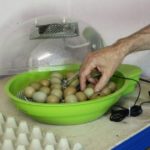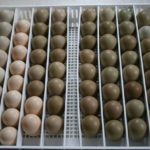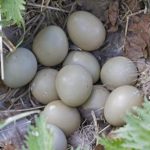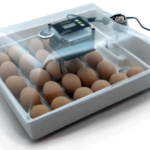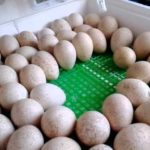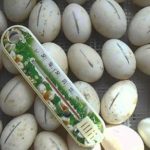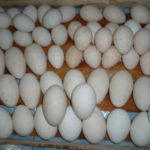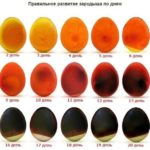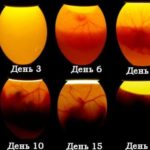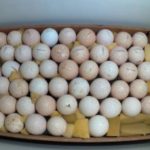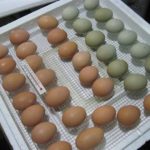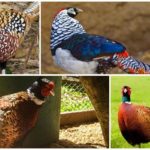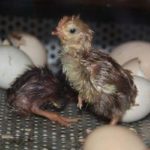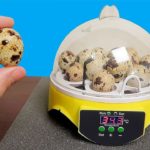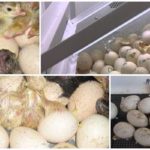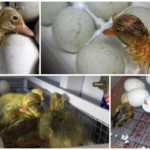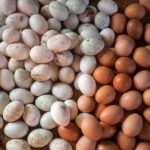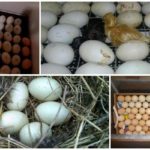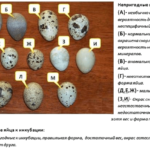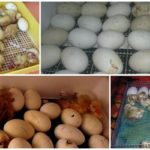Pheasant breeding - profitable business. The meat of these birds sells well in cafes and restaurants; dishes made from them are an excellent treat for friends and family. When pheasant eggs are incubated, the survival rate of hatched chicks and their numbers increase greatly, quickly increasing the bird population on the farm. The final result depends on knowing the intricacies of this process.
Pros and cons of incubation
Pheasants are rarely kept on private farmsteads, but there are farms that breed these birds. Female pheasants have a poorly expressed nasi instinctlife, they abandon their nests, so an incubator for producing pheasant chicks is the best solution.
Before being placed in the incubator, eggs are sorted by size; they can be stored in a cool room for up to 2 weeks; after this period, the likelihood of chicks hatching is noticeably reduced.
Selection and storage
Pheasant eggs are gray or greenish in color and smaller than chicken eggs. When selecting, you should pay attention to their size and shape. For incubation, large specimens of regular shape are selected, without growths or cracks in the shell.
Important: it is better to choose gray eggs for laying; chicks hatch from them much more often.
Store the selected incubation material in the dark, at a temperature from +5 to +12 °C. It is laid vertically, with the blunt end up. If eggs are to be stored for more than 3 days before incubation, they should be turned daily to prevent the yolk from sticking to the shell. Such eggs will not hatch into chicks.
The room should have good ventilation and humidity 60-70%.Before laying, the eggs are calibrated, the smaller ones are laid separately - the chicks hatched from such eggs are smaller and weaker than the rest of the population and require special attention, but quickly catch up with their brothers.
Disinfection and cleaning of dirt
Heavily soiled eggs are cleaned with a soft brush. It is not recommended to wash them. To prevent infection from occurring during incubation, all selected specimens are disinfected. They are placed for 3 minutes in a warm solution of potassium permanganate (potassium permanganate), solution temperature +30 °C. After this, the eggs need to be removed from the solution and dried without wiping.
The incubation material must be cleaned and disinfected 1-2 hours after collection. Eggs should be kept clean. When cleaning and disinfecting, it should be taken into account that pheasant eggs have a more fragile shell than chicken eggs.
Setting up an incubator at home
To hatch pheasant chicks, you do not need a special incubator. A version of the system with which chickens, quails, and other poultry were bred is quite suitable. The incubator must be clean; it must be turned on in advance to warm it up, a day before adding the material. The eggs are kept in the incubator for 4-5 weeks.
Before laying, they are examined using an ovoscope. The device allows you to select eggs without flaws (displaced air chamber, foreign inclusions). In fertilized specimens, a darker spot is clearly visible - the embryo.
Pheasant egg incubation chart
In order for chicks to hatch from eggs, a certain temperature and humidity are required at each stage of incubation and a special regime. Changing parameters leads to the death of the embryo. Chicks hatch within 25-30 days, depending on the type of pheasant.
| Incubation period | Set temperature | Humidity | Number of turns per day | Ventilation |
| 1-7 days | 37,8 | 60-65 % | Every 6 hours | They don't produce |
| 8-14 days | 37,8 | 60-65 % | Every 4-6 hours | They don't produce |
| 15-21 days | 37,8 | 60-65 % | After 4-6 hours | 1-2 times a day |
| 22-24 days | 37,5 | 75-80 % | — | — |
Eggs are turned over from days 3 to 18 of incubation. The babies hatch together, after birth they are left for a short time in the incubation chamber, allowing them to dry.
Further care of pheasants
After the chicks are completely dry, they should be fed and watered. This is done 6-12 hours after birth. The chicks are helpless; they do not know how to feed and drink on their own. To teach the chicks to eat, lightly tap the container with food; to give them something to drink, they lower their beaks into the drinking bowl. Before the first feeding, the chicks are given boiled water. To improve appetite and protect against infections, water pheasants with a solution of glucose and biomycin. Per liter of water add 10-15 grams of 40% glucose and 0.25 grams of biomycin.
In the first days, the birds are not limited in food. For the first 2 weeks of life, the chicks are fed every 2 hours during the day. At night, 2 feedings are enough, with more food left for the chicks. From 3 weeks to 2 months - 6-7 times a day, up to 3 months - 4-5 times a day. After three months of age, the chicks are transferred to 3 meals a day, like adult birds.
On day 1, babies are given a finely chopped, hard-boiled chicken egg and a little nettle, the next day ant larvae and mealworm larvae are introduced into the diet, then the diet is varied with green onion feathers. From the 15th day, pheasant chicks are fed purified crushed grain, and once a week they are given boiled, finely chopped meat. From this age, salt, chalk, and bone meal are introduced into the diet.
After 1.5 months the grain is not crushed. The diet of birds should include corn, millet, wheat, and oats. Additionally, vitamin complexes and feed yeast are introduced into the diet. Babies should have strong legs, clear eyes and clean fluff. Healthy chicks are active and curious, they move their heads intensely and squeak. Young animals are moved into enclosures after 35-40 days.
What problems might you encounter?
Eggs for incubation should be purchased from specialized farms; upon purchase, breeders advise beginners; they can be contacted with doubts and questions about the contents. For drinking, it is better for baby pheasants to install nipple drinkers so that the babies cannot get wet.
Nimble and shy pheasant chicks begin to fly after 2-3 weeks of life. The aviary for chicks must be covered from above so that they do not fly away.
High-quality nutrition and maintenance of birds allows you to quickly form a breeding stock and start making money from breeding them. Pheasants are easy to keep and are not susceptible to most avian diseases. Birds naturally have strong immunity; in Chinese medicine, pheasant meat is considered healing, it is used to restore strength after serious illnesses, and is recommended for people with cancer. Males are often purchased as ornamental birds due to their bright plumage. That is why the costs of breeding and keeping birds quickly pay off.

